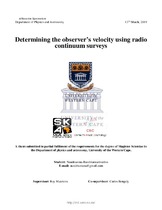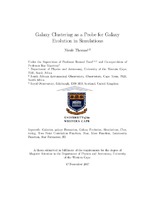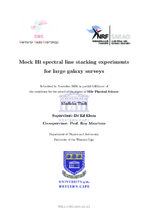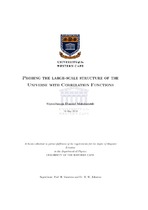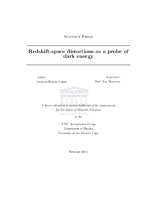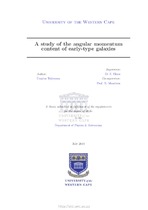Browsing Magister Scientiae - MSc (Physics) by Author "Maartens, Roy"
Now showing items 1-11 of 11
-
Determining the observer’s velocity using radio continuum surveys
Randriamiarinarivo, Nandrianina (University of the Western Cape, 2019)In the standard (‘concordance’) model of Cosmology, there is a fundamental assumption that the Universe is statistically isotropic and homogeneous on large scales, known as the Cosmological Principle. The Cosmological ... -
Galaxy Clustering as a Probe for Galaxy Evolution in Simulations
Thomas, Nicole (University of the Western Cape, 2017)Studying clustering on small scales (<10Mpc) over a large span of red- shifts allows us to connect galaxies to underlying cosmic large-scale structure, and thereby provide constraints on the physical processes that drive ... -
Measuring the quasar luminosity function below the detection threshold
Malefahlo, Eliab (University of the Western Cape, 2016)The radio emission of radio-quiet active galactic nuclei (AGN) is thought to be from star formation and AGN related emission. I investigate these sources using 1.4 GHz radio data from FIRST and three optical quasars samples ... -
Mock HI spectral line stacking experiments for large galaxy surveys
Tladi, Modisha (University of Western Cape, 2019)The study of neutral atomic hydrogen (HI) plays a vital role in improving the knowledge about galaxy evolution since HI serves as the raw fuel for star formation. However, the current knowledge about it is limited to the ... -
Probing the large-scale structure of the universe with correlation functions
Matshawule, Siyambonga Donald (University of the Western Cape, 2014)In this project we explore a new statistical package called KSTAT that computes the 2PCF and higher order correlation functions, such as the 3PCF, on BOSS, making use of high performance computing facilities to improve ... -
Probing the primordial Universe using the SKA in combination with other cosmological surveys
Matthewson, William (University of the Western Cape, 2019)Next-generation surveys of the large-scale structure of the Universe will be of great importance in allowing us to extract invaluable information about the nature of the Universe and the physical laws that govern it, at ... -
Redshift-space distortions as a probe of dark energy
Gouws, Liesbeth-Helena (University of Western Cape, 2014)We begin by finding a system of differential equations for the background and linearly perturbed variables in the standard, ɅCDM model, using the Einstein Field Equations, and then solving these numerically. Later, we ... -
A study of the angular momentum content of early-type galaxies
Tshiwawa, Unarine (University of the Western Cape, 2019) -
Testing Gravity with MeerKAT and the SKA
Kopana, Mponeng (University of the Western Cape, 2020)The new 64-dish radio telescope array MeerKAT will be absorbed into the international Square Kilometre Array (SKA) in late 2020s. These two telescope arrays will produce three-dimensional maps of the integrated intensity ... -
Testing gravity with redshift-space distortions, using MeerKAT and the SKA
Viljoen, Jan-Albert (University of the Western Cape, 2019)The growth rate of large-scale structure is a key probe of gravity in the accelerating Universe. Standard models of Dark Energy within General Relativity predict essentially the same growth rate, whereas Modified Gravity ... -
Testing the statistical isotropy of the universe using radio survey data
Baloyi, Mathobela Albert (University of the Western Cape, 2019)The Cosmological Principle forms part of one of the most fundamental hypotheses of modern Cosmology. So it is very important to assess whether it holds true using observational data, or whether it consists of a mathematical ...

